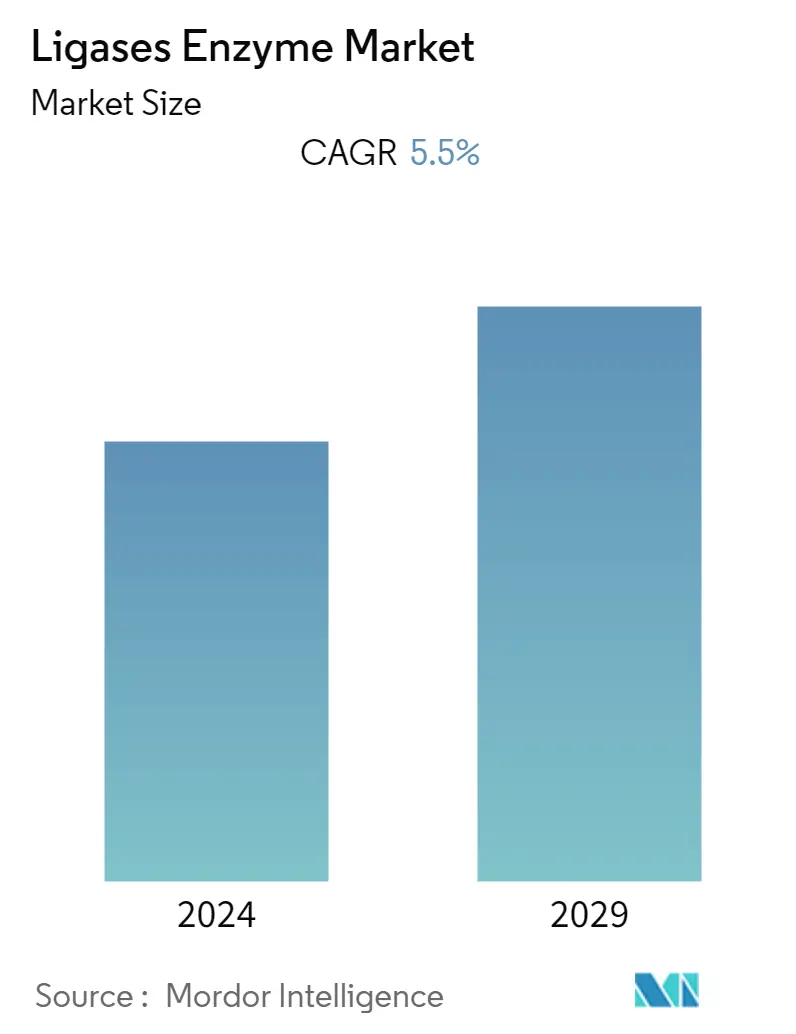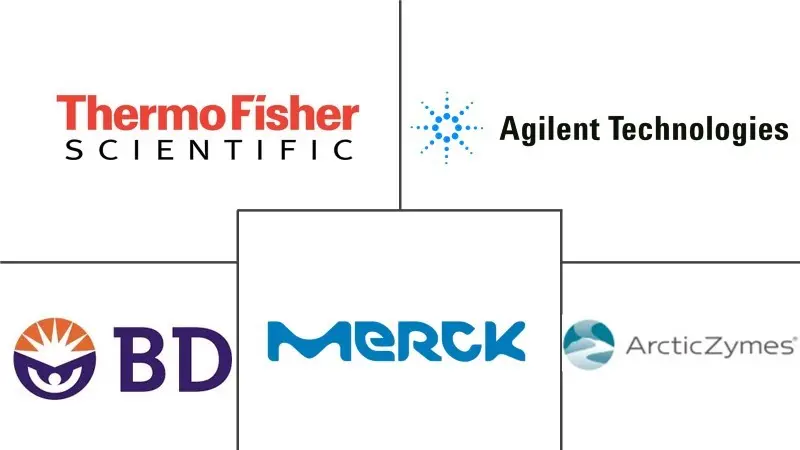Market Size of Ligases Enzyme Industry

| Study Period | 2019 - 2029 |
| Base Year For Estimation | 2023 |
| Forecast Data Period | 2024 - 2029 |
| Historical Data Period | 2019 - 2022 |
| CAGR | 5.50 % |
| Fastest Growing Market | Asia Pacific |
| Largest Market | North America |
Major Players
*Disclaimer: Major Players sorted in no particular order |
Ligases Enzyme Market Analysis
The Ligase Enzyme Market is anticipated to record a CAGR of nearly 5.5% during the forecast period.
The COVID-19 pandemic had a notable effect on the ligases enzyme market during the pandemic period. There were many research studies providing insight into the applications of ligases enzyme for identifying potential targets of therapeutic strategies against COVID-19 that significantly impacted the market's growth. For instance, the NCBI article published in April 2021 mentioned that HECT family members of E3 ligases were likely novel biomarkers for COVID-19, as well as new possible targets of therapeutic strategy easily tested in clinical trials. Such studies proving the potential benefits of ligase enzymes in the therapeutic usage against COVID-19 significantly impacted the market's growth. In addition, the demand for the ligases enzyme is expected to remain intact due to the applications in various studies of mutant strains of COVID-19, thereby boosting the market's growth over the forecast period.
The growth of the ligase enzyme market may be attributed to the increasing prevalence of various infectious diseases and genetic birth disorders due to its potential diagnostic and therapeutic properties. For instance, as per the WHO data published in 2022, an estimated 10.6 million tuberculosis cases were recorded globally in 2021. Thus, the high prevalence rate of people with tuberculosis surges the demand for effective and early diagnosis, thereby driving the ligases enzyme market. Also, another WHO data published in 2022 found that between January 24 and February 6, 2022, approximately 12,368 people tested positive for influenza viruses, with 8,423 (68.1%) being categorized as influenza A and 3,945 (31.9%), as influenza B. There were nearly 2,483 (93.6%) influenza A viruses and 171 (6.4%) influenza A(H1N1) pdm09 subtypes (H3N2). Such incidences of infectious diseases globally are expected to drive the demand for ligases enzyme, thereby contributing to the growth of the market. Similarly, the advent of ligases as therapeutic interventions for cancer is also expected to be one of the crucial driving factors of the market. For instance, an NCBI research study published in March 2022 stated that small ubiquitin-like modifier (SUMO) relation is a reversible post-translational modification that plays an essential role in numerous aspects of cell physiology, including cell cycle regulation, DNA damage repair, and protein trafficking and turnover, both of which are crucial for cell homeostasis. Thus, such research studies proving the effective therapeutic benefits of ligase enzymes for cancer are also expected to boost the market's growth.
However, the risk of the high sensitivity of the enzyme is expected to hinder the market growth.
Ligases Enzyme Industry Segmentation
As per the scope of the report, ligases are specific types of enzymes that speed up the joining of two large molecules, such as DNA. These enzymes are extensively used in cloning, mutation detection, gene synthesis, and next-generation sequencing. Ligase enzymes are also used for correcting dysfunctions and a lack of DNA ligases in humans.
The Ligases Enzyme Market is Segmented by Source (Microorganisms (Bacteria, Viruses, and Other Microorganisms), Animals, and Plants), Application (Polymerase Chain Reaction, Cloning, Mutation Detection, Next-generation Sequencing, and Drug Target), End User (Diagnostic Centers and Hospitals, and Research Institutes), and Geography (North America, Europe, Asia-Pacific, Middle East and Africa, and South America). The market report also covers the estimated market sizes and trends for 17 different countries across major regions, globally. The report offers the value (USD million) for the above segments.
| By Source | |||||
| |||||
| Animal | |||||
| Plant |
| By Application | |
| Polymerase Chain Reaction | |
| Cloning | |
| Mutation Detection | |
| Next-generation Sequencing | |
| Drug Target |
| By End User | |
| Diagnostic Centers and Hospitals | |
| Research Institutes |
| Geography | ||||||||
| ||||||||
| ||||||||
| ||||||||
| ||||||||
|
Ligases Enzyme Market Size Summary
The ligases enzyme market is poised for significant growth, driven by its applications in diagnostics and therapeutics across various infectious diseases and genetic disorders. The market's expansion is supported by the increasing prevalence of diseases such as tuberculosis and influenza, which necessitate effective diagnostic solutions. Additionally, the role of ligases in therapeutic interventions for cancer, particularly through mechanisms like the SUMO pathway, underscores their potential in advancing cancer treatment. The COVID-19 pandemic further accelerated market growth as research highlighted the therapeutic potential of ligases in combating the virus, thereby maintaining demand through ongoing studies of mutant strains. Despite the promising growth trajectory, the market faces challenges due to the high sensitivity of these enzymes, which could impede broader adoption.
North America emerges as a key region in the ligases enzyme market, bolstered by its robust pharmaceutical and research sectors. The region's growth is fueled by the rising incidence of infectious diseases, prompting demand for advanced diagnostic and therapeutic solutions. Collaborative efforts among market players, such as partnerships and strategic alliances, are enhancing market penetration and innovation. Companies like QIAGEN and Takara Bio are actively engaging in initiatives to develop advanced diagnostic tools, further propelling market dynamics. The competitive landscape is characterized by both global and local players, with technological advancements enabling smaller firms to capture market share. Overall, the ligases enzyme market is set to experience steady growth, driven by its critical role in healthcare advancements and disease management.
Ligases Enzyme Market Size - Table of Contents
-
1. MARKET DYNAMICS
-
1.1 Market Overview
-
1.2 Market Drivers
-
1.2.1 Increase in Prevalence of Birth Genetic Disorders and Infectious Diseases
-
1.2.2 Advent in Ligases as Therapeutic Interventions of Cancer
-
1.2.3 Rising Research Activities for Sequencing Applications
-
-
1.3 Market Restraints
-
1.3.1 Risk of High Sensitivity of the Enzyme
-
-
1.4 Porter's Five Forces Analysis
-
1.4.1 Threat of New Entrants
-
1.4.2 Bargaining Power of Buyers/Consumers
-
1.4.3 Bargaining Power of Suppliers
-
1.4.4 Threat of Substitute Products
-
1.4.5 Intensity of Competitive Rivalry
-
-
-
2. MARKET SEGMENTATION (Market Size by Value - USD million)
-
2.1 By Source
-
2.1.1 Microorganisms
-
2.1.1.1 Bacteria
-
2.1.1.2 Virus
-
2.1.1.3 Other Microorganisms
-
-
2.1.2 Animal
-
2.1.3 Plant
-
-
2.2 By Application
-
2.2.1 Polymerase Chain Reaction
-
2.2.2 Cloning
-
2.2.3 Mutation Detection
-
2.2.4 Next-generation Sequencing
-
2.2.5 Drug Target
-
-
2.3 By End User
-
2.3.1 Diagnostic Centers and Hospitals
-
2.3.2 Research Institutes
-
-
2.4 Geography
-
2.4.1 North America
-
2.4.1.1 United States
-
2.4.1.2 Canada
-
2.4.1.3 Mexico
-
-
2.4.2 Europe
-
2.4.2.1 Germany
-
2.4.2.2 United Kingdom
-
2.4.2.3 France
-
2.4.2.4 Italy
-
2.4.2.5 Spain
-
2.4.2.6 Rest of Europe
-
-
2.4.3 Asia-Pacific
-
2.4.3.1 China
-
2.4.3.2 Japan
-
2.4.3.3 India
-
2.4.3.4 Australia
-
2.4.3.5 South Korea
-
2.4.3.6 Rest of Asia-Pacific
-
-
2.4.4 Middle East and Africa
-
2.4.4.1 GCC
-
2.4.4.2 South Africa
-
2.4.4.3 Rest of Middle East and Africa
-
-
2.4.5 South America
-
2.4.5.1 Brazil
-
2.4.5.2 Argentina
-
2.4.5.3 Rest of South America
-
-
-
Ligases Enzyme Market Size FAQs
What is the current Ligases Enzyme Market size?
The Ligases Enzyme Market is projected to register a CAGR of 5.5% during the forecast period (2025-2030)
Who are the key players in Ligases Enzyme Market?
Becton, Dickinson and Company, Agilent Technologies, Merck KGaA, Thermo Fisher Scientific and ArcticZymes Technologies are the major companies operating in the Ligases Enzyme Market.

